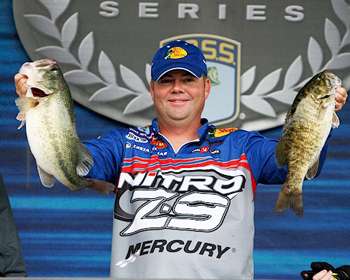
When it comes to gaining fishing knowledge, many bass anglers look to discover new lures or learn a new technique. But relatively few put enough effort into understanding bass behavior through the seasons — especially what is actually going on underwater during summer in deep lakes. Elite Series pro Brian Snowden sheds some light on the often-mentioned but seldom-explained thermocline.
"The thermocline is really nothing more than two layers of water that overlap each other," he explains. "You've got the warmer water with higher oxygen content on top, and in deeper reservoirs, you'll have a bottom layer that's much colder and contains much less oxygen."
Snowden explains that, with some assistance from your electronics with the sensitivity "turned way up," the thermocline is easily distinguishable as a faint black line on the sonar screen. Once identified, much of the water located below the thermocline can be eliminated due to lack of oxygen.
"Finding the thermocline is especially helpful in the summer when you're fishing vertically in deep, clear reservoirs," Snowden points out. "The fish are never going to be below the thermocline. They might get close to that cooler water, but they're going to position themselves in the water that has the highest oxygen content." When targeting fish located just above the thermocline, Snowden favors either a jigging spoon or a drop shot.
One thing to keep in mind, Snowden says, is that thermoclines are not present in all lakes. "It has to be a deeper lake," he says. "If the lake is shallow, a thermocline just won't develop. Also, if the lake has a lot of water movement — Kentucky Lake, for example — it won't generally develop because of the current."
Snowden says that on his home lake of Table Rock, the thermocline begins to appear in June when the water begins to warm. "The thermocline is going to stay until the water starts cooling down. What's going to happen is the surface temperature becomes equal to the bottom of the lake. When that happens, the lake 'turns over.'"
Snowden explains that when the turnover occurs, it's actually a movement of water from the bottom to the surface. "You might begin to see little groups of algae off the bottom."
When the fall turnover occurs, Snowden points out that fishing can become extremely difficult on deep, clear water reservoirs. "When this happens it dirties the water that's normally very clear, and it also allows the bass to move anywhere they want," he says.
"On Table Rock, in the fall of the year, you can catch bass as deep as 60 feet once the thermocline breaks up. The fish can begin moving anywhere within the water column. It can really make finding fish difficult because it effectively doubles the search zone."
The good news is that, according to Snowden, when the fall breakup occurs, it doesn't happen simultaneously across the lake. "The lake will turn over in sections," he reveals. "You can move from one section of the lake to another and still be able to fish the thermocline. It usually takes a few weeks for it to cover an entire lake."




